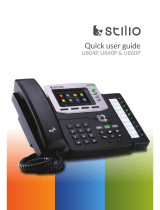
Dial Now .......................................................................................................................... - 32 -
Area Code ........................................................................................................................ - 33 -
Block Out ......................................................................................................................... - 34 -
Feature Synchronisation ................................................................................................... - 35 -
WatchDog ......................................................................................................................... - 36 -
Action URL/URI .............................................................................................................. - 37 -
Using the Basic Call Functions ...................................................... - 40 -
Making a call ............................................................................................................................ - 40 -
Call Devices ..................................................................................................................... - 40 -
Call Methods .................................................................................................................... - 40 -
Password dial ................................................................................................................... - 42 -
Call Completion ............................................................................................................... - 42 -
Answering a call....................................................................................................................... - 43 -
Answering an incoming call ............................................................................................. - 43 -
Denying an incoming call ................................................................................................ - 43 -
DND ................................................................................................................................. - 43 -
Call Forward .................................................................................................................... - 44 -
Intercom ........................................................................................................................... - 45 -
During an Active Call .............................................................................................................. - 46 -
Mute ................................................................................................................................. - 46 -
Call Hold .......................................................................................................................... - 46 -
Call Waiting ..................................................................................................................... - 46 -
Call Transfer ..................................................................................................................... - 47 -
3-way Conference ............................................................................................................ - 48 -
Network Conference ........................................................................................................ - 48 -
Voicemail ......................................................................................................................... - 49 -
Using the Advanced Phone Functions .......................................... - 52 -
Account Setting ........................................................................................................................ - 52 -
TLS .................................................................................................................................. - 52 -
DNS-SRV ......................................................................................................................... - 53 -
Network Setting ....................................................................................................................... - 54 -
PC Port Setting ................................................................................................................. - 54 -
VLAN Setting .................................................................................................................. - 55 -
LLDP ................................................................................................................................ - 56 -
HTTPS ............................................................................................................................. - 57 -
Maintenance Tasks ................................................................................................................... - 58 -
Administrator Mode ......................................................................................................... - 58 -
Administrator/User Password .......................................................................................... - 58 -
Reboot .............................................................................................................................. - 59 -
Reset to Factory ............................................................................................................... - 59 -
Firmware Update .............................................................................................................. - 60 -
Decryption ........................................................................................................................ - 61 -




















